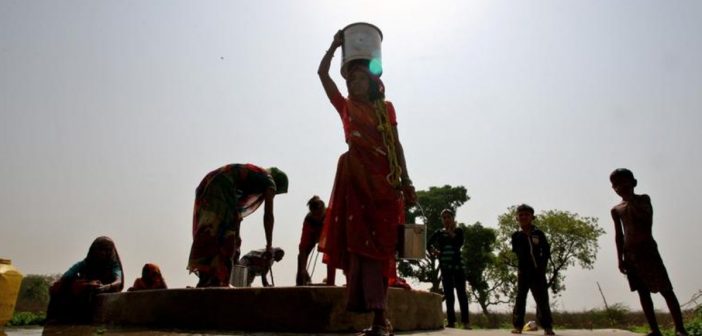India is currently grappling with an intense heat wave, with temperatures soaring past 45°C (113°F) in several regions. This extreme weather event is wreaking havoc on public health, causing a significant loss of work hours, and disrupting businesses and agriculture – the backbone of the Indian economy.
Health Concerns on High Alert
The scorching heat poses a severe threat to human health. Heatstroke, dehydration, and worsening pre-existing conditions like heart disease are major concerns. According to a 2019 study published in The Lancet, heatwaves are responsible for an estimated 125,000 deaths in India annually. This year’s heat wave is expected to exacerbate this grim statistic.
Lost Productivity: Counting the Cost in Man-Hours
The intense heat significantly impacts worker productivity. Studies have shown that labor productivity can decline by as much as 25% when temperatures exceed 35°C (95°F). With millions of Indians working outdoors in construction, agriculture, and other sectors, the ongoing heat wave could translate into billions of lost work hours and a significant dent in the economy.
Businesses Feeling the Heat: Disruptions Across Sectors
Businesses across various sectors are feeling the heat – literally and figuratively. Power outages due to increased strain on the electricity grid are disrupting operations in factories and offices. Additionally, the heat can damage heat-sensitive products and disrupt supply chains. The tourism industry, a major source of revenue, may also suffer as scorching temperatures deter travel plans.
Agriculture Wilting Under the Sun: A Threat to Food Security
The agricultural sector is particularly vulnerable to heat waves. High temperatures can lead to stunted crop growth, reduced yields, and even crop failure. A 2017 study by the World Bank estimated that heat stress could reduce wheat yields in India by up to 6%. This poses a significant threat to India’s food security, especially for vulnerable populations.
Looking Ahead: Mitigating the Impact
The ongoing heat wave underscores the need for India to be better prepared for such extreme weather events. Some potential solutions include:
- Investing in heat action plans for cities, including early warning systems and public awareness campaigns.
- Encouraging heat-resistant crop varieties and improved irrigation practices to protect agricultural production.
- Promoting worker safety measures, including flexible working hours for outdoor workers during peak heat hours.
India’s scorching summer serves as a stark reminder of the growing threat of climate change. By taking proactive measures, the country can mitigate the impact of heat waves on public health, economic productivity, and food security.
The heatwave’s impact extends beyond the immediate effects on health and productivity. One of the most concerning ripple effects is the strain it places on India’s already stressed water resources.
- Increased Water Demand: The intense heat significantly increases water demand for both human consumption and agricultural irrigation. Households require more water for drinking, bathing, and cooling purposes. Parched crops require more frequent watering to survive.
- Decreased Water Availability: Heatwaves often coincide with droughts, leading to lower river and groundwater levels. This creates a dangerous situation where demand soars while supply dwindles.
- Water Scarcity Threatens Sanitation: A lack of sufficient water can compromise sanitation and hygiene practices, increasing the risk of waterborne diseases.
The Domino Effect on Energy
The heatwave also creates a complex situation for India’s energy sector:
- Soaring Power Demand: As temperatures rise, the demand for electricity for air conditioners and coolers surges. This puts immense pressure on the national grid, leading to potential blackouts.
- Reduced Power Generation: Heatwaves can also impact power generation capacity. For instance, thermal power plants require large amounts of water for cooling, and limited water availability can hinder their efficiency.
- A Vicious Cycle: Power outages due to high demand and low supply can further disrupt water treatment plants, exacerbating the water crisis.
The Long-Term Economic Impact
The heatwave’s economic impact will likely extend far beyond the immediate disruptions. Here’s a glimpse into the potential long-term consequences:
- Disrupted Supply Chains: Heat-related disruptions across various sectors can lead to a domino effect, impacting supply chains and causing shortages of essential goods.
- Higher Prices: Reduced agricultural output and disruptions in transportation can lead to price hikes for food and other commodities.
- Investment and Growth Slowdown: The overall economic slowdown caused by the heatwave can deter investments and dampen economic growth.
A Call to Action: Building Resilience
The ongoing heatwave serves as a wake-up call for India. To build resilience against such extreme weather events, the country needs a multi-pronged approach:
- Investing in Renewable Energy: Shifting towards renewable energy sources like solar and wind power can help reduce reliance on thermal power plants and lessen the strain on water resources.
- Water Conservation Measures: Implementing water conservation measures in agriculture and promoting rainwater harvesting can help manage water scarcity.
- Climate-Smart Agriculture: Adopting climate-smart agricultural practices like drought-resistant crops and efficient irrigation systems can help protect food security.
India’s scorching summer paints a concerning picture of the challenges the country faces due to climate change. By taking decisive action and investing in long-term solutions, India can build resilience, mitigate the impact of future heat waves, and ensure a more sustainable future for its citizens and its economy.





